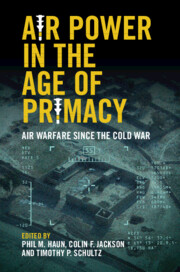Book contents
- Air Power in the Age of Primacy
- Air Power in the Age of Primacy
- Copyright page
- Contents
- Figures
- Tables
- Contributors
- Preface
- Abbreviations
- 1 Air Power in the Age of Primacy
- 2 Remote Warfare: A New Architecture of Air Power
- 3 Deliberate Force: Ambivalent Success
- 4 Hoping for Victory: Coercive Air Power and NATO’s Strategy in Kosovo
- 5 Operation Enduring Freedom
- 6 The Result Is Never Final: Operation Iraqi Freedom
- 7 Israeli Air Force Effectiveness during the Second Lebanon War (2006)
- 8 Libya 2011: Hollow Victory in Low-Cost Air War
- 9 Coercing a Chaos State: The Saudi-Led Air War in Yemen
- 10 Russia’s Air War Win in Syria
- 11 Air Power in the Battle of Mosul
- 12 Retrospect and Prospect: Air Power in the Age of Primacy and Beyond
- Index
2 - Remote Warfare: A New Architecture of Air Power
Published online by Cambridge University Press: 16 December 2021
- Air Power in the Age of Primacy
- Air Power in the Age of Primacy
- Copyright page
- Contents
- Figures
- Tables
- Contributors
- Preface
- Abbreviations
- 1 Air Power in the Age of Primacy
- 2 Remote Warfare: A New Architecture of Air Power
- 3 Deliberate Force: Ambivalent Success
- 4 Hoping for Victory: Coercive Air Power and NATO’s Strategy in Kosovo
- 5 Operation Enduring Freedom
- 6 The Result Is Never Final: Operation Iraqi Freedom
- 7 Israeli Air Force Effectiveness during the Second Lebanon War (2006)
- 8 Libya 2011: Hollow Victory in Low-Cost Air War
- 9 Coercing a Chaos State: The Saudi-Led Air War in Yemen
- 10 Russia’s Air War Win in Syria
- 11 Air Power in the Battle of Mosul
- 12 Retrospect and Prospect: Air Power in the Age of Primacy and Beyond
- Index
Summary
This chapter examines the new architecture of air power enabled by remote warfare. The development of remotely piloted aircraft (RPA) such as the Predator and Reaper, combined with global communication networks, manned aircraft, and precision-strike capabilities, created a far-flung kill web that exploited permissive skies to target pernicious threats. Leveraging local surrogates and special operations forces along with increasingly sophisticated sensors and weapons, RPAs rendered high-value terrorists, enemy concentrations, and military infrastructure visible and vulnerable in Afghanistan, Iraq, Pakistan, Yemen, Syria, Libya, and Somalia. Persistent surveillance-strike capabilities reduced risk to US and allied forces and fostered rapacious demand for RPAs as contemporary air warfare became increasingly remote, digitized, and precise. As the kill web’s architecture evolved, RPAs became vehicles of political expediency. Yet new questions emerged about the allure and efficacy of remote warfare and air power operations in countries not at war with the United States.
Keywords
- Type
- Chapter
- Information
- Air Power in the Age of PrimacyAir Warfare since the Cold War, pp. 26 - 53Publisher: Cambridge University PressPrint publication year: 2021

